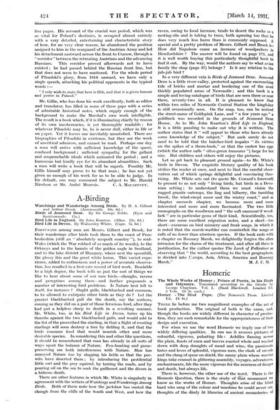A-Birding
FORTUNATE among men are Messrs. Gilbert and Brook, for their wanderings after birds took them to the coast of Pem- brokeshire (still an " absolutely unspoilt country "), to mid- Wales (which the War robbed of so much of its woods), to the Orkneys and to the haunts of the golden eagle in Scotland, and to the lake district of Hungary, where nest the spoonbill,
the glossy ibis and the great white heron. This varied expe- rience, added to enthusiasm and a power of accurate observa- tion, has resulted in a first-rate record of bird work. Readable to a high degree, the book tells us just the sort of things we like to hear about some of our rare birds—choughs, ravens and peregrines among them—and further propounds a number of interesting bird problems. Is Nature best left to itself, for instance ? Ought gulls, blackbacked and common, to be allowed to extirpate other birds as they do ? Let the greater blackbacked gull die the death, say the authors, coming as they did on a pair of those ferocious fowl, after they bad put a helpless sheep to death in a revolting manner.
Mr. White, too, in his Bird Life in Devon, turns up his thumbs against the two blackbacked gulls, and would add to the list of the proscribed the starling, in that a flight of roosting starlings will soon destroy a tree by defiling it, and that the birds consume food that would nourish other and. more
desirable species. In considering this and other like questions,
it should be remembered that man has already in all sorts of ways upset the balance of Nature. Fox-hunting and game. preserving are both interferences with Nature. Man has
annoyed Nature too by slagging his fields so that the pee-
wits have deserted them ; by introducing the pestilential little owl and the grey squirrel, by tarring the roads, and by pouring oil on the sea to soak the guillemot and the divers in a hideous death.
There are other features in which Mr. White is singularly in agreement with the writers of Watchings and Wanderings Among Birds. Both of them- note how the jackdaw has ousted the ctough from the cliffs of the South and West, and how the raven, owing to local increase, tends to -desert the ioek,s as a nesting-site and is taking to trees; both agreeing too that he does very much less harm than is commonly supposed. A special and a pretty pioblem of Mesers. Gilbert and Brook is How did Napoleon cause an increase of woodpeckers in Herefordshire ? The answer will be found on page 171, and it is well worth buying this particularly thonghtfill book to find it out. By the way, would the authors say to what avian family the shop (page 47) belongs? Is it any relation to the jub-jub bird ?
In a very different vein is Birds of Jesmond Dene. Jesmond Dene is a little river-valley, protected against the encroaching tide of bricks and mortar and bordering one of the most thickly populated areas of Newcastle ; and this book is a simple and loving catalogue of birds that are seen there or near there, seventy-two in all. It is pleasant to know that within two miles of Newcastle Central Station the kingfisher is still occasionally seen. On the map, too, can be noticed the street-name of Goldspink Lane, and " a few years ago " a goldfinch was recorded in the grounds of Jesnuond Dene House. As to Mr. John Kearton's Bird Life in England, it is a little puzzling to make out why it is written. The author states that it " will appeal to those who have already some knowledge of the subject." But such surely do not need to be told that the butcher-bird impales " its victims on the spikes of a thorn-bush," or that the curlew has eggs (which the author calls " olive-green treasures ") large for her size. But children and others will enjoy the pictures.
Let us get back to pleasant ground again—to Mr. White's birds in Devon. The exquisite literary quality of his book strikes the reader at once, and next to that the careful obser- vation out of which springs delightful and convincing theo- rizing. Mr. White sets out (to quote Mr. Coward's foreword) to present to us not only " living birds, but birds in a Devo- nian setting ; to understand them we must vision the rugged granite outcrops, the ling and bilberry, the tumbling brook, the wind-swept moor and the wintry coast," and as chapter succeeds chapter, we become more and more interested and more and more fascinated. The two little monographs on the woodwren and " the soft enamour'd wood- lark " are in particular gems of their kind. Scientifically, too, there are some excellent migration notes, and a short—too short—excursus on bird mimicry and freak songs, in which it is noted that the marsh-warbler can counterfeit the songs or calls of no fewer than nineteen species. If the book ends with a chapter on Romney Marsh, we delightedly forgive the alien intrusion for the charm of the treatment, and after all there is justification, for the author quotes The Leech of Folkestone as observing that " the world, according to the best geographers, is divided into Europe, Asia, Africa, America and Romney























































 Previous page
Previous page